Folk Dances of India: Art & Culture of Ancient India
India has been a land of varied culture, traditions, and ethos. Diversity in India has been its cultural part. Folk Dances of India in ancient times presented a unique blend of Art & Culture.
A brief description of all the Folk Dances of India are accounted below:-
Pandavani, Kudiyattam, Chavittu, Natakam, Chhau, Yakshagana, Kalbelia Dance, Ghoomar Dance, Bhangra, Giddha, Jatra, Bhavai, Raibenshe, Santhali, Bihu, Jhumur, Losar Shona, Chuksam, Dangi, Naati, Bhotiya Dance, Langvir Dance, Chiraw, Gaur Dance, Chaitra festival dance, Lambadi, Dhimsa, Tamasha, Dumhal and Bhand.
Folk Dances of India- Portrayal of the Ethnic Heritage
Pandavani (Chhattisgarh)

This is a popular form of story-telling dance form prevalent among the tribals of the Chhatisgarh which serves as a means of both entertaining and educating the people.
Pandavani is a form of Folk Dances of India which narrates the story of the five Pandava brothers (protagonists of the epic Mahabharata) and are of two types: Kapila and Vedamati.
A team of Pandavani performers consists of one main narrator-singer and one or two musician-cum-singers, who play on the tabla and the harmonium. The main narrator-singer holds a tambura (stringed musical instrument), decorated with small bells and peacock feathers in one hand and Kartal (a pair of cymbals) on the other.
Kudiyattam (Kerala)

Kudiyattam is one of the earliest of the theatrical arts of Kerala. Kudiyattam presents a full-fledged drama or select portions thereof.
Several actors appear on the stage at the same time as in a modern drama. The actor portraying the male characters is known as the Chakiar and one who portrays the female characters is known as the Nangiar.
The Nangiar also clangs the cymbals and chants Sanskrit verses which the Chakiar enacts. A feature of Kudiyattam is that there is a Vidushaka or clown who repeats in Malayalam all the Sanskrit verse being uttered by the actors.
Kudiyattam as a folk dances of India was used to be performed in temples within multi-pillared theatres known as kuthambalams (built specially for the purpose) by architects, according to the norms laid down in Bharatamuni’s Natyasastra.
The Kuthambalam was a storehouse of the finest sculptures, particularly wood carvings and paintings depicting scenes from the epics and the Puranas.Today Kudiyattam almost stands on the verge of extinction and is performed only in a few major temples like Irinjalakuda, Perumanam, Kottiyur etc.
Chavittu Natakam (Kerala)

This interesting art form was evolved by the church, under the guidance of the Portuguese missionaries, as a Christian alternative to the Hindu Kathakali. It presents stories from the lives of Christian saints and the entire history of Christianity. It is one of the famous forms of Folk Dances of India.
In sharp contrast with Kathakali, the actors in Chavittu Natakam not only speak and sing but also stamp on the wooden platform with their feet to the rhythm of the songs and the beating of drums. The movements of the actors are more lively and vigorous rather than graceful or artistic.
Women are not allowed to participate in Chavittu Natakam. Vocal, as well as instrumental music, play an important place in this art form. Chavittu Natakam is modeled more along the lines of the Opera and Ballet than after Kathakali. Unfortunately, with the passage of time, Chavittu Natakam is on the brink of oblivion today.
Chhau (Orissa/Bihar/Bengal)
The origin of word Chhau is shrouded in mystery. According to some, Chhau might have originated from Chhaya (shadow). Another possibility is that the name sprung from dancing masks (locally known as Chhau) used by the performers of Purulia Chhau.
Yet others opine that Chhau has got its name from chhauni – the camps organized during military operations. It is likely that Chhau dancers entertained the troops resting at these camps during intervals between battles and campaigns.
The Chhau dance is native to the eastern parts of India and is one of the very famous folk dances of India. It probably originated as a martial art, which is why it comprises vigorous movements and leaps. During the 18th and the19th centuries, many of the princely rulers of Orissa evinced a keen interest in the development of this art. They maintained troupes that performed on special occasions and during festivals.
Yakshagana (Karnataka)

A native of Karnataka, this theatre form is basically folk but with strong classical overtones. Unlike the stylised costumes and masks of Kathakali, Yakshagana is a true people’s theatre, often staged in the paddy fields at night. It revolves around the stories from Ramayana, the Mahabharata, and the Puranas.
It is one of the famous forms of Folk Dances of India.
Although the name literally means: Song of the celestial beings, Yakshagana is more earthy and mundane than fantastic. There is both mystery and robustness about this dance form, in which singing and drum-beats merge with the dancing, and words with gestures. The colorful costumes and the dancers’ contours blend in with the rest of the elements.
Kalbelia Dance (Rajasthan)
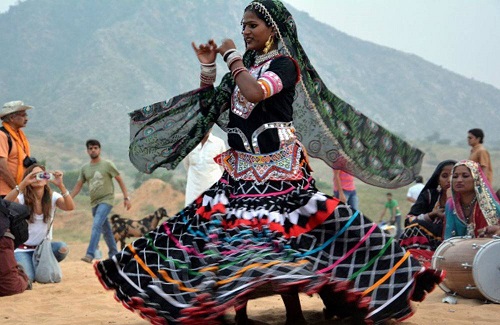
This fascinating dance is performed by the womenfolk hailing from the Kalbelia community, who pursue the centuries-old profession of catching snakes and trading snake venom. Hence, the dance movements and the costumes have an uncanny resemblance to the slithery creatures.
The dancers clad in black swirling skirts (with ethnic designs) sway sinuously to the accompaniment of pungi (an ethnic trumpet), dufli and the been – the woodwind instrument used by the snake charmers. Two or three women sing in a shrill, high-pitched voice, while the others are engrossed in dancing. The combination of vigorous, zestful and perfect movements synchronizing with the enchanting musical is indeed a treat to both eyes and ears.
Ghoomar Dance (Rajasthan)

This is basically a community dance performed by groups of women on auspicious occasions. The name is derived from the word ghoomna (pirouetting). It is one of the famous forms of Folk Dances of India.
This dance has simple basic steps where the ladies move gently, gracefully in circles. The Ghoomar is the characteristic dance of the Bhils – a tribal community inhabiting various parts of Rajasthan. Men and women sing alternately and move clockwise and anticlockwise, affording free play to the numerous folds of the swirling ghagras (gathered skirts), donned by the women.
Bhangra (Punjab)
Though the historians of culture opine that the dance may have originated at the time of the wars with Alexander, no one is sure whether it existed until about five hundred years ago. It has come to light that during the 14th and 15th centuries, the farmers in Punjab danced and sang songs about village life while working in the fields. Gradually it became part of harvest as well as New Year celebrations (Baisakhi, April 13).
Bhangra is a lively form of folk music and a very popular folk dance of India. While performing Bhangra, people sing Boliyaan (lyrics or couplets) in the Punjabi language. Some of the dancers play the dhol (a large drum), beating it with a stick while others play the flute and dholak (a smaller drum).Bhangra eventually became a part of social occasions including weddings.
Giddha (Punjab/ Haryana)
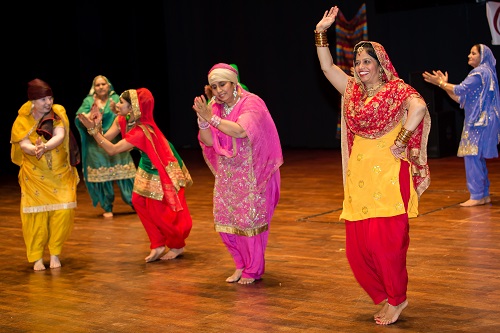
This dance form has its roots in the Punjab region, now split up between India and Pakistan. It is a folk dance performed by women and girls and is considered to be the female counterpart of Bhangra.
As a part of the dance, women of all ages form a circle, clapping their hands and sing small couplets. Two or three women come to the center and dance vigorously while responding to these couplets. The embroidered dupattas (stoles) and the chunky jewelry of the participants further enhance the tempo of the dance.
Jatra (W.Bengal)

The name literally means ‘going’ or ‘journey’. It is performing art combining acting, songs, music and dance, stylised delivery, exaggerated gestures and orations, all bordering on melodrama. Jatra is believed to have developed from ceremonial functions conducted before setting out on a journey. Yet others believe that it developed from processions brought out in honor of various deities.
The original Jatra as an art form may be traced back to at least the 16th century. In Chaitanyabhagavad (1548), Brindavan Das describes a dramatic performance during which Sri Chaitanya (who founded the Bhakti movement in Bengal) himself played the role of Rukmini (Krishna’s wife). There were no actresses, and female roles were played by male actors, who were supported by musical and choral accompaniment.
A typical Jatra was held in open space, on level ground, with the audience seated on the stage. There was no raised platform or curtain. There were occasional exchanges between spectators and performers. It is one of the famous forms of Folk Dances of India.
A Jatra performance generally lasted about four hours and was divided into five acts – an influence of the 19th-century colonial theatre. Following each act, the prompter would ring a bell to signal the end of the act. During the intervals between acts, there were songs, dances and comic displays aplenty. The Jatra performance usually ended a little before daybreak. The themes were mainly religious.
Bhavai (Gujarat)
Bhavai (meaning strolling players) is a popular folk theatre form of Gujarat. Veshas (costume) or Bhavai dance dramas are also known as Swang (vaudeville /melodrama).
Bhavai is as much a form of entertainment as it is a kind of ritual offering made to the goddess Amba. In the courtyard of the Ambaji temple near Mount Abu, the Navratri festival is celebrated with a good many Bhavai performances. Amba (mother goddess) is the presiding deity of Bhavai performances.
According to scholars, the term Bhavai is composed of two words- Bhava and Aai. Bhava means universe and Aai is the mother; together they signify the mother of the universe, Amba.
A salient feature of the Bhavai is subtle social criticism laced with pungent humor. Some of the Bhavai dance-dramas present a scathing review of the caste-ridden social structure. People belonging to divergent social strata, from the king to the pauper are portrayed in Bhavai. Humor plays a vital role in a Bhavai performance, which is evident enough even while dealing with mythological personages.
The language of Bhavai is a blend of Gujarati, Hindi, Urdu, and Marwari.
The musical instruments accompanying Bhavai performances are the pakhwaj (an indigenous drum), jhanjha (cymbals), sarangi (a stringed instrument), and the harmonium. The music is Hindustani classical , interspersed with local tunes.
A characteristic instrument of the Bhavai is the bhungal – a four feet long copper pipe, played during dance sequences and also to indicate the entry of important characters.
Bhavai (Rajasthan)
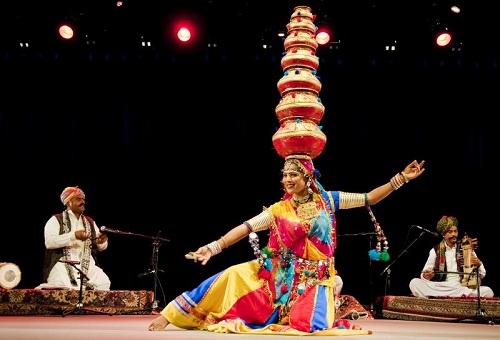
A folk dance of the same name exists in Gujarat’s neighboring state of Rajasthan.
In Rajasthan, this spectacular dance form consists of veiled women dancers balancing nearly seven or nine brass pitchers as they dance dexterously, pirouetting and swaying with the soles of their feet perched on top of a glass or on the edge of a sword. There is a sense of nail-biting suspense as the performance reaches a crescendo.
Raibenshe (Bengal)

Among the various martial dances of Bengal, the Raibenshe folk dances are remarkable for their expression of military energy and discipline and the atmosphere of martial excitement they create. The vigorous and manly movements of the body, together with the stirring notes of the drum, incite courage and daring. They afford a significant reminder that Bengalis, now believed to be a non-martial race, were once renowned for their military prowess.
This dance was performed by a low-caste community of Bengal called Bagdis, who were professional guardsmen of the erstwhile feudal lords of Bengal, and were trained in the use of sticks, staves, daggers, short swords, This dance displayed the acrobatics of a quarterstaff master- (raibansh, a long wooden staff) made with bamboo.
Santhali (Bengal/Bihar)
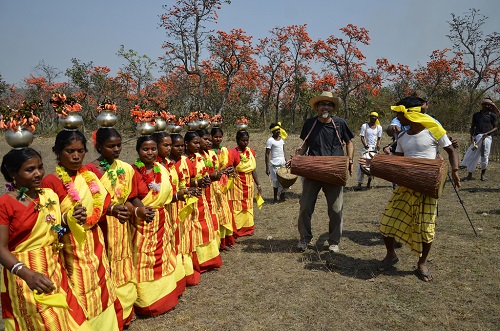
The Santhals, especially the women-folk are worshippers of nature, whom they think to be of a benevolent spirit. Besides nature, they are also great worshippers of banadevis (female deities who are guardians of the forests).
To mark the festive occasions, the entire community performs different kinds of dances which turn out to be enchanting, accompanied by the mellifluous songs.
The songs and the dances are performed with some supporting musical instruments like dhamsa (a percussion instrument), and madal (a hand drum which made of wood or clay. Both heads are played, holding the drum horizontally), singa (curved animal horn for blowing).
Bihu (Assam)
It is the most widespread folk dance of Assam and is enjoyed by the old and the young alike. The dance performed on the occasion of the month-long Bihu festival that comes in mid-April when the harvesting of crops is over.
The participants are young men and women, who gather in the open, in the daytime and dance together in circles or parallel rows. Placing their hands on the small of their backs, the dancers move their shoulders backward and forwards while swaying from side to side.
The dance is supported by drums and pipes. Intermittently, the dancers sing, usually of love. Bihu demonstrates the soul of the Assamese at its richest. Bihu is one of the very important and popular folk dances of India.
Jhumur (Bengal)
 The dance gets its name from the cluster of bells worn around the ankles, which make a clanging noise.There are many variations of Jhumur.
The dance gets its name from the cluster of bells worn around the ankles, which make a clanging noise.There are many variations of Jhumur.
This dance is sometimes performed as a ritual worship of gods and goddesses, sometimes for courting and lovemaking, and yet again as a prayer for rainfall. This dance incorporates songs and dialogues, which depict the joys and sorrows, yearning and aspirations of the everyday lives of the common people.
It is believed that Jhumur was originally a means of recreation between phases of tedious agricultural work. This dance form has also been adopted by the Santhals. Probably the most entertaining form of Jhumur is the Bhaduria, performed as thanksgiving for a bountiful monsoon. It is one of the famous forms of Folk Dances of India.
Losar Shona Chuksam (Himachal Pradesh)

Dangi (Himachal Pradesh)

This is a lively dance performed by the womenfolk of Chhatrari village in Chamba district. The song accompanying the dance is like a question-answer session between the two groups.
The dance begins with a slow tempo but gathers momentum as the dancers begin to whirl and spin. It is also a well-known form of Folk Dances of India.
Naati (Himachal Pradesh)
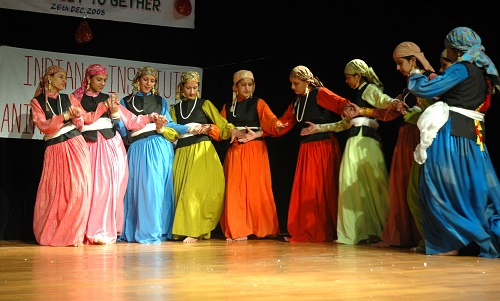
Performed by the inhabitants of Kullu district, this dance is immensely popular. The menfolk clad in swirling tunics, churidaars, sashes and colorful caps link their hands and move in step to varying rhythms, dancing for hours on end. This dance has now been modified so that women can take part in it too.
The musical instruments accompanying these dances include damane (a huge bowl-shaped drum played with two drumsticks), anga, dhol (a large drum slung across the neck, rests on the chest and played with two thin sticks), dholak (hand drum), karnal (clappers), khanjiri (tambourine) and jhanja (large cymbals).
Bhotiya Dance (Uttaranchal)

This dance is performed by Bhotia (a mongoloid race with the majority living in Bhutan) community living in this area and is connected with their death and funeral ceremonies.
These people believed that the soul of a dear departed resides in the body of a goat or sheep, and it can be liberated by means of dancing. It is one of the famous forms of Folk Dances of India.
Langvir Dance (Uttaranchal)
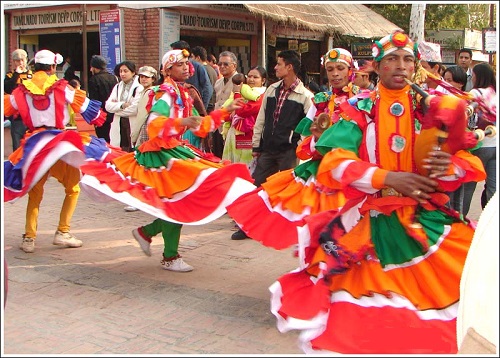
This is an acrobatic dance performed solely by the local menfolk.
As a part of this dance, the dancer climbs a pole and balances himself on his navel on the top of the pole.To the accompaniment of drum beats and music, he balances skillfully and rotates on his belly, performing several acrobatic stunts.
Chiraw (Mizoram)
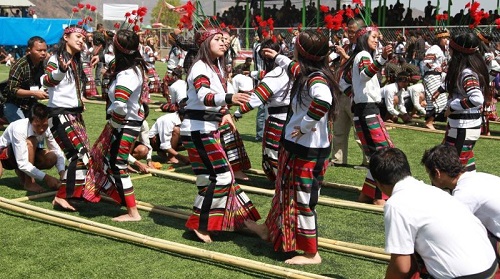
A highly colorful dance from the north-eastern state of Mizoram, it employs a grid of bamboo poles in its performance.
The dancers move by stepping alternately in and out of the pairs of horizontal bamboos, held against the ground, by people sitting on either side, facing each other, who tap the bamboos open and closed in rhythmic beats. The bamboos when clapped produce a sharp sound which provides the rhythm of the dance.
The dancers step in and out of the squares formed by the bamboos with ease and grace. The pattern and stepping off the dance resemble the movements of birds, swaying of trees and so forth.
Gaur Dance (Madhya Pradesh)
The most popular among the Madhya Pradesh dances are associated with the Bastar district, which has a predominantly tribal population. It is one of the well-known form of Folk Dances of India.
The Gaur dance of the Sing Marias or Tallaguda Marias (bison-horn Marias) inhabiting south Bastar is a spectacular dance, depicting the hunting spirit of the tribe. The word ‘Gaur’ means a ferocious bison.
The call for a dance is given by sounding a bamboo trumpet or a horn. Wearing head-dresses decorated with strings of cowrie shells and plumes of peacocks, menfolk equipped with flutes and drums assemble at the dance venue.
Women adorned with brass fillets and bead necklaces over their tattooed bodies soon join the assembly. They carry dancing sticks (Tirududi) in their right hands which they tap to match the drum-beats. They dance in groups besides the menfolk.
The men with drums usually move in a circle and create a variety of dancing patterns as the dancing gathers momentum. As a part of the dance, they attack one another and even chase the female dancers. This dance incorporates the movements of a bison namely charging, tossing of horns, hurling wisps of grass into the air, to name a few.
Chaitra Festival Dance (Madhya Pradesh)

This is a famous dance of the Gond tribal community of the Bastar district; it is performed after the harvesting of crops is over, as a gesture of thanksgiving to the goddess Annapurna (goddess of plenty) for her bounty and seek her blessings for the next crop.
Men and women dance vigorously in circles, semi-circles, and rows, holding onto each others’ waists. It is one of the famous forms of Folk Dances of India.
The dancers wear peacock feathers on their heads and adorn themselves with gaily coloured costumes and garlands of shells and pearls. The dancers move around in rhythmic movements, their feet synchronizing with the music of various instruments like Shehnai, Nagada (kettle drum) , Timki, Tapri, Dholak (a hand drum) Madur, Singa (wind instrument curved out of animal horn) and Kohuk.
Lambadi (Andhra Pradesh)
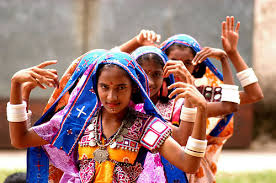
The Lambadis are a tribal community (a.k.a Sengalis and Banjaras) who inhabit the state of Andhra Pradesh .The womenfolk wear very colourful Rajasthani-style clothes (decorated with tiny mirrors and cowrie shells) and lots of jewellery including innumerable ivory bangles and brass anklets and strings of cowrie shells.
The gait of the dance is initially slow but gradually gains momentum, to the rhythm of the drum beats. The lyrics of the songs accompanying the dance are mainly in the Lambadi dialect. The language in which the songs are sung is derived from their own Lambadi dialect.
The songs are replete with meaning and set to sensuous tunes. Associated with various tasks like harvesting, sowing, planting, the dance is a colourful exposition of lives of rural folk of Andhra Pradesh. It is a widely acclaimed form of Folk Dances of India.
Dhimsa (Andhra Pradesh)
It is a folk dance of India, which is popular among the members of Valmiki, Bagata, Khond and Kotia tribes inhabiting the Araku Valley region of Vishakhapatam, in Andhra Pradesh. It is generally performed in local fairs and festivals of the area.
Women attired in tribal dresses, finery and ornaments dance form a chain dance to the beat of typical tribal instruments like Mori, Thudum and Dappu which are played by the menfolk. There exist eight different categories of Dhimsa. For instance, in Gunderi/Usku Dimsa a male dancer while singing sends invitations to the females to dance with him.
Thereafter, the male and female with firm steps move forward and backwards, while standing in a circle. Potar Tola Dimsa depicts the picking up leaves. Half of the dancers stand side by side in a row, while the rest stand behind in same manner, keeping their hands on shoulders of dancers in the front row.
Turning their heads to right and left the two rows march forward and backward. Bhag Dimsa demonstrates the art of escaping a tiger’s attack. It is a famous form of Folk Dances of India.
Half of the dancers form a circle holding hands. They stand on their toes, bowing and raising their heads. Moving round swiftly, the rest of the dancers enter the circle and form a serpentine coil.This is repeated several times.
The Dhimsa dances by and large conform to the rhythm of either Aditala (8-beat cycle) or Rupakatala (a seven-beat cycle that is subdivided into 3+2+2).Tala literallay means a rhythmical pattern that determines the rhythmical structure of a composition.
Tamasha (Maharashtra)

This happens to be an important dance form and folk theatre of Maharashtra. This dance form developed in the16th century. The word Tamasha in Persian, means fun or entertainment.
Some scholars opine that this form of theatre was inspired by two forms of ancient Sanskrit drama – the “Prahasana” and the “Bhana”. It is a form of Folk Dances of India.
The love songs (Lavanis) form the core of Tamasha and are immensely popular.
The instruments used during a Tamasha performance include Dholki (drum), Tuntuni (a single string instrument), and Manjeera (cymbals), Daf (a tambourine-like instrument with a single leather surface), Kade (a metal triangle), Lejim (an instrument with a jangling sound), harmonium and ghungroos (ankle bells).
This folk art is mainly associated with the Kolhati and Mahar communities of Maharashtra.
Dumhal (Kashmir)
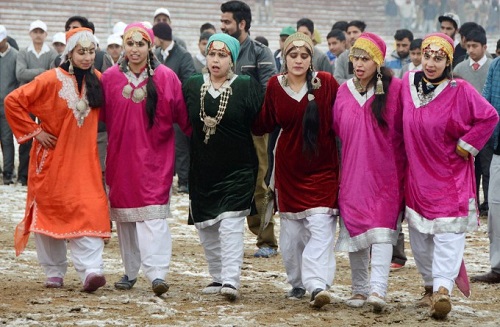
Dumhal is a dance performed by the men folk of the Wattal tribe of Kashmir, on important social occasions. The performers wear long colorful robes, tall conical caps, studded with beads and shells.
The party of dancers arrives at the venue in a procession carrying a banner in a ceremonial fashion. The banner is dug into the ground, after which the men begin to dance in a circle.
The musical accompaniments comprise a drum and the vocal singing of the dancers themselves. It is a form of Folk Dances of India.
Bhand Pather (Kashmir)

This dance form may well be compared to the Jatra of Bengal. In fact, it is a combination f drama and dance with a satirical bend, by means of which social evils and malpractices are depicted and lampooned.
It is performed during social and cultural functions. Bhand Jashan is performed by a group of 10 to 15 artists in their traditional style accompanied by light music, for regaling the audience. It is indeed a form of Folk Dances of India.
Yes, they are from the Folk Dances of India !!!








